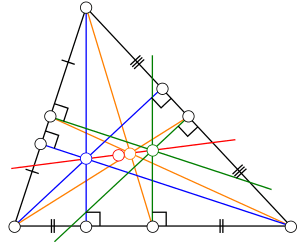Euler line

In geometry, the Euler line, named after Leonhard Euler (US /ˈɔɪlər/, OY-lər or UK /ˈɔɪlə/, OY-lə), is a line determined from any triangle that is not equilateral. It passes through several important points determined from the triangle, including the orthocenter, the circumcenter, the centroid, the Exeter point and the center of the nine-point circle of the triangle.[1]
Triangle centers
Euler showed in 1765 that in any triangle, the orthocenter, circumcenter and centroid are collinear.[2] This property is also true for another triangle center, the nine-point center, although it had not been defined in Euler's time. In equilateral triangles, these four points coincide, but in any other triangle they are all distinct from each other, and the Euler line is determined by any two of them.
Other notable points that lie on the Euler line include the de Longchamps point, the Schiffler point, and the Exeter point.[1] However, the incenter generally does not lie on the Euler line;[3] it is on the Euler line only for isosceles triangles, for which the Euler line coincides with the symmetry axis of the triangle and contains all triangle centers.
Equation
Let A, B, C denote the vertex angles of the reference triangle, and let x : y : z be a variable point in trilinear coordinates; then an equation for the Euler line is
Parametric representation
Another way to represent the Euler line is in terms of a parameter t. Starting with the circumcenter (with trilinear coordinates  ) and the orthocenter (with trilinears
) and the orthocenter (with trilinears  , every point on the Euler line, except the orthocenter, is given by the trilinear coordinates
, every point on the Euler line, except the orthocenter, is given by the trilinear coordinates
formed as a linear combination of the trilinears of these two points, for some t.
For example:
- The centroid has trilinears
 , corresponding to the parameter value
, corresponding to the parameter value  .
. - The nine-point center has trilinears
 , corresponding to the parameter value
, corresponding to the parameter value  .
. - The De Longchamps point has trilinears
 , corresponding to the parameter value
, corresponding to the parameter value  .
.
Slope
In a Cartesian coordinate system, denote the slopes of the sides of a triangle as 
 and
and  and denote the slope of its Euler line as
and denote the slope of its Euler line as  . Then these slopes are related according to[4]:Lemma 1
. Then these slopes are related according to[4]:Lemma 1
Thus the slope of the Euler line (if finite) is expressible in terms of the slopes of the sides as
Moreover, the Euler line is parallel to an acute triangle's side BC if and only if[4]:p.173 
Lengths of segments
On the Euler line the centroid G is between the circumcenter O and the orthocenter H and is twice as far from the orthocenter as it is from the circumcenter:[5]:p.102
The center of the nine-point circle lies along the Euler line midway between the orthocenter and the circumcenter.[1] Thus the Euler line could be repositioned on a number line with the circumcenter O at the location 0, the centroid G at 2t, the nine-point center at 3t, and the orthocenter H at 6t for some scale factor t.
Furthermore, the squared distance between the centroid and the circumcenter along the Euler line is less than the squared circumradius R2 by an amount equal to one-ninth the sum of the squares of the side lengths a, b, and c:[5]:p.71
Right triangle
In a right triangle, the Euler line contains the median on the hypotenuse—that is, it goes through both the right-angled vertex and the midpoint of the side opposite that vertex. This is because the right triangle's orthocenter, the intersection of its altitudes, falls on the right-angled vertex while its circumcenter, the intersection of its perpendicular bisectors of sides, falls on the midpoint of the hypotenuse.
See also
References
- ↑ 1.0 1.1 1.2 Kimberling, Clark (1998). "Triangle centers and central triangles". Congressus Numerantium 129: i–xxv, 1–295.
- ↑ Euler, Leonhard (1767). "Solutio facilis problematum quorundam geometricorum difficillimorum". Novi Commentarii academiae scientarum imperialis Petropolitanae 11: 103–123. E325. Reprinted in Opera Omnia, ser. I, vol. XXVI, pp. 139–157, Societas Scientiarum Naturalium Helveticae, Lausanne, 1953, MR 0061061.
- ↑ Schattschneider, Doris; King, James (1997). Geometry Turned On: Dynamic Software in Learning, Teaching, and Research. The Mathematical Association of America. pp. 3–4. ISBN 978-0883850992.
- ↑ 4.0 4.1 Wladimir G. Boskoff, Laurent¸iu Homentcovschi, and Bogdan D. Suceava, "Gossard’s Perspector and Projective Consequences", Forum Geometricorum, Volume 13 (2013), 169–184.
- ↑ 5.0 5.1 Altshiller-Court, Nathan, College Geometry, Dover Publications, 2007 (orig. Barnes & Noble 1952).
External links
- Altitudes and the Euler Line and Euler Line and 9-Point Circle at cut-the-knot
- Triangle centers on the Euler line, by Clark Kimberling.
- An interactive applet showing several triangle centers that lies on the Euler line.
- Weisstein, Eric W., "Euler Line", MathWorld.
- "Euler Line" and "Non-Euclidean Triangle Continuum" at the Wolfram Demonstrations Project
- Nine-point conic and Euler line generalization and A further Euler line generalization at Dynamic Geometry Sketches







